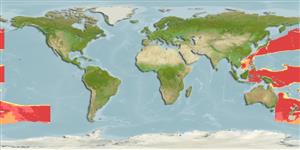>
Lophiiformes (Anglerfishes) >
Oneirodidae (Dreamers)
Etymology: Oneirodes: Greek, 'oneiros' = a dream or dreamlike or out of a dream (suggesting this fish is so strange and marvelous that can exist only in dreams) (Ref. 86949); sabex: Name from the acronym formed from the initial letters of the name 'Southeast Asian Bioluminescence EXpedition'; in recognition of the important ichthyological contribution made by those involved (Ref. 26783).
Environment: milieu / climate zone / depth range / distribution range
Ecologie
marien bathypelagisch; diepte 780 - 1800 m (Ref. 86949). Deep-water
Pacific Ocean: SE Asia, Indonesian, eastern Australian and New Zealand waters.
Grootte / Gewicht / Leeftijd
Maturity: Lm ? range ? - ? cm
Max length : 18.9 cm SL (female); common length : 12.1 cm SL mannelijk / geslacht onbekend; (Ref. 26783)
Korte beschrijving
Determinatiesleutels | Morfologie | Morfometrie
Dorsale zachte stralen (totaal) : 5 - 6; Anale zachte stralen: 4. Characterized by having escal morphology: short anterior appendage, laterally compressed, without pigmented internal tube; presence of medial appendages; short, simple, cylindrical to laterally compressed; short and broad subopercle, dorsal end tapering to a point, without indentation on posterodorsal margin; length of ventral fork of opercle 24.2-27.1% SL; ratio of lengths of dorsal and ventral forks of opercle0.48-0.64; upper fork of opercle supported by 2-3 bony ribs in some large specimens; absence of epibranchial teeth; presence of teeth on pharyngobranchial II; upper jaw with 26-52; lower jaw teeth 36-50; teeth on vomer 4-10; dorsal fin rays 5-6; anal fin rays 4; pectoral fin rays 14-17; head length 32.2-39.5% SL; head depth 34.2-41.5% SL; premaxilla length 26-32.1% SL; length of lower jaw 33.2-45.3% SL; illicium length 14.4-26.5% SL (Ref. 86949).
Levenscyclus en paargedrag
Maturities | Voortplanting | Spawnings | Egg(s) | Fecundities | Larven
Paxton, J.R., D.F. Hoese, G.R. Allen and J.E. Hanley, 1989. Pisces. Petromyzontidae to Carangidae. Zoological Catalogue of Australia, Vol. 7. Australian Government Publishing Service, Canberra, 665 p. (Ref. 7300)
Status op de Rode Lijst van het IUCN (Ref. 130435)
Gevaar voor de mens
Harmless
Gebruik door de mens
Tools
Speciale rapporten
Download XML
Internetbronnen
Estimates based on models
Preferred temperature (Ref.
123201): 3.1 - 5.9, mean 4.4 °C (based on 309 cells).
Fylogenetische diversiteitsindex (Ref.
82804): PD
50 = 0.5000 [Uniqueness, from 0.5 = low to 2.0 = high].
Bayesian length-weight: a=0.01995 (0.00906 - 0.04395), b=3.01 (2.83 - 3.19), in cm total length, based on all LWR estimates for this body shape (Ref.
93245).
Trofisch niveau (Ref.
69278): 4.3 ±0.7 se; based on size and trophs of closest relatives
Weerstandsvermogen (Ref.
120179): Gemiddeld, minimale populatieverdubbelingstijd 1,4-4,4 jaar (Preliminary K or Fecundity.).
Fishing Vulnerability (Ref.
59153): Low vulnerability (13 of 100).
